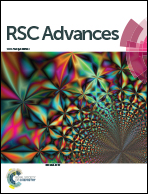Cucurbit[7,8]urils binding to gefitinib and the effect of complex formation on the solubility and dissolution rate of the drug
Abstract
The host–guest interactions of macrocyclic hosts cucurbit[7,8]urils (Q[7,8]) with prototropic forms of the drug gefitinib (diprotonated: GH2+ and neutral: G) were investigated by electronic absorption spectroscopy. The two hosts Q[7,8] showed strong binding to the diprotonated form due to the ion–dipole interaction between the polar carbonyl oxygens of the hosts and the cationic GH2+. Q[7] and Q[8] showed similar binding to the neutral gefitinib, shifting its pKa by about 1.4 units and 0.7 units downward, respectively. Determination of the thermodynamic parameters of complex formation showed that the formation of inclusion complexes between gefitinib and Q[7,8] was enthalpy controlled, suggesting that hydrophobic and van der Waals interactions were the main driving forces. Moreover, the formation of inclusion complexes between Q[7] and Q[8] and gefitinib was confirmed by 1H NMR, which showed that the phenyl moiety of gefitinib was entrapped in the Q[7] cavity or likely located on the outside of the Q[7] cavity. The two models showed a fast dynamic equilibrium. Our results indicate that the complexation of gefitinib with Q[7] could enhance the solubility and dissolution rate of gefitinib in aqueous solution.
![Graphical abstract: Cucurbit[7,8]urils binding to gefitinib and the effect of complex formation on the solubility and dissolution rate of the drug](/en/Image/Get?imageInfo.ImageType=GA&imageInfo.ImageIdentifier.ManuscriptID=C3RA45017A&imageInfo.ImageIdentifier.Year=2014)

 Please wait while we load your content...
Please wait while we load your content...